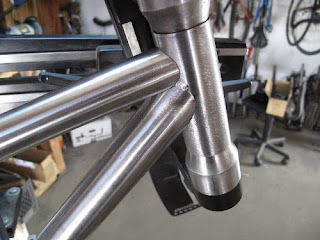 For what it's worth, Chris, this picture is of your frame. Not very exciting, but hey, it's something!
For what it's worth, Chris, this picture is of your frame. Not very exciting, but hey, it's something!This is a common situation on many 29er frames (and other frames that are very small) - the toptube has to be mitered to both the head tube *and* the downtube. This is known as a compound miter, or compound joint.
Of course, almost all frames have at least one compound miter - at the bottom bracket shell, where the downtube and seat tube usually (though not always) overlap as well. There are two ways to make a joint like this:
-Join (weld or braze) one tube completely, then miter the second tube to fit and weld it. This is how most high end frames are made. Generally the seat tube is completely welded to the BB shell, then the downtube is mitered to the seat tube. At the head tube end, the downtube is completely joined to the headtube, and the toptube is then mitered to fit. You can see the portion of the weld that I've completed (the top of the DT/HT joint) sticking out under the toptube in the photo.
-Miter everything, lay the tubes into place, and then tack/weld around all the exposed portions of the joint. This is common on cheaper bikes, because it's quick (the second tube doesn't have to be mitered to take into account the weld bead from the first part of the joint), but it's also weaker and can end up causing weird problems like odd noises from the unjoined but contacting surfaces of the tubes rubbing together.
5 comments:
Hi Walt, thanks for the observations about compound miters. I have a question that I hope you can find a moment to answer: with butted seat tubes, does the thick end go down or up?
-Nathan
Down. The upper part of the tube is frequently only .6mm, which is why you'll see reinforcing collars at the seat/top tube junctions on so many frames, Walt's included.
Nathan -
Depends on the tube. If you've got a single butted (ie, generally .9/.6, the thick section goes at the bottom and is welded/brazed to the BB. The thin section has to be reinforced with a lug or a sleeve.
With a double butted (externally butted, generally) seat tube, the thickest (1.0-1.2mm wall) section goes at the *top*, and the .9m section is at the bottom. The .6mm section is in the middle, of course.
There are a lot of other solutions out there, but those are the two most common.
I love posts like this, it is cool to see the tech that goes into frame building.
thanks for the class and nice fish mouth with a clean weld.
Post a Comment